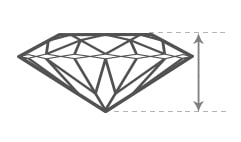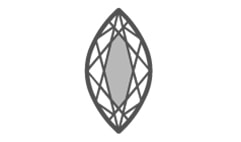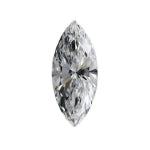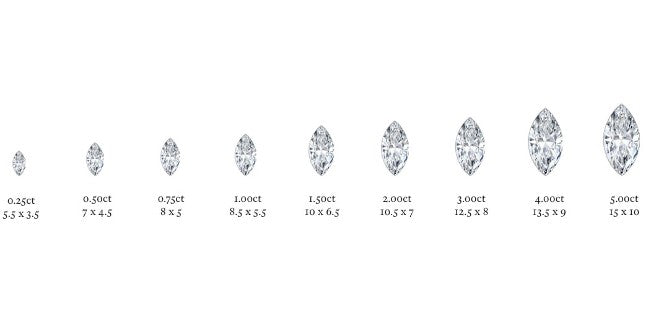Meet Marquise Cut Diamonds
The marquise diamond is a classic and historic diamond shape that captures hearts thanks to its whimsical shape that resembles a smile. Although we don't blame you if you see something else. Marquise cut stones are also called boat-shaped, football-shaped and eye-shaped diamonds, or the navette. None of these are incorrect; in fact, the “navette” cut diamond, which translates from the French language to “little ship,” is often considered similar in shape to all these things. Despite their dramatic look, marquise cut diamond are rarely seen in engagement rings; but for some non-traditional brides, that only increases the appeal of these loose diamonds. Here's what you need to know if you're considering getting a marquise cut.
TABLE OF CONTENTS
What you Need to Know About the Marquise Diamond Cut
We'll get more into who created this captivating diamond shape later, but they did start quite the trend. The shape was invented specifically for the diamond, but the marquise cut trend eventually spread to sapphires, rubies, and other precious stones. Although the marquise never hits the popularity of other diamond shapes in engagement rings, it's the perfect stone for couples looking for a unique ring to celebrate their love and devotion.
We've all seen marquise stones in rings, but maybe you didn't realize they weren't engagement rings. Traditionally this stone has been set in more cocktail and right-hand rings than their engagement cousins, but that has been changing. There's good reason to choose this stone, too. It has almost 60 facets within its rounded central shape and sharply pointed ends, which means it truly delivers on the drama. You'll get plenty of sparkle from the marquise cut stones but also style. This shape is particularly beloved for its unique ability to make fingers look thinner and longer.
Marquise Diamond Popularity
There's a lot to love about the marquise cut diamond, even if you're unfamiliar with this less common shape. We'll get into those details later, but suffice it to say this shape is worth considering. Those looking for a unique engagement ring should consider the marquise diamond. Unlike the round and cushion, which you constantly see in engagement rings, a marquise diamond engagement ring turns heads simply because the center stone's shape is out of the ordinary. But it's not just offbeat brides sporting marquise cut rings. You'll find plenty of celebrity engagement rings featuring the dramatic center stone:
- Catherine Zeta-Jones wears a marquise cut diamond engagement ring, but she turned the style on its head and opted for an east-west setting
- Ashlee Simpson sports a stunning vintage style engagement ring featuring a center marquise diamond surrounded by rubies in an Art Deco design
- Portia de Rossi's marquise diamond ring from Ellen DeGeneres features an east-west set marquise diamond and pink accent diamonds on the band
- Christina Milian shows off her marquise cut engagement ring from Jas Prince, which features a double French set pave band
- Victoria Beckham might currently wear a pear shaped diamond, but her original engagement ring from David featured a marquise diamond
- Jennifer Lopez's started her first marriage with a marquise diamond ring, though she's now wearing a ring with an emerald cut diamond
The Visual Appeal of Marquise Cut Diamonds
The marquise is a variant of round and pear shaped diamonds and, like the oval, is a perfect complement to long, slender fingers. But, as we mentioned, it can also create this effect thanks to its shape. The long-thin body and pointed ends draws the eye up, so your fingers will look longer and thinner when you're sporting this stone in your engagement ring. But there are benefits for your ring as well as your hand.
This diamond shape's elongated body can make its appearance larger than its actual carat weight. So you'll be able to buy the same carat weight and have your stone look bigger than someone who purchases, say, a round brilliant diamond. For brides-to-be who prioritize the size of their rings, this is a major draw of the unique marquise cut. But size isn't the only concern if you're looking to commit to this diamond shape in your engagement ring.
Marquise Shape Ring Setting Recommendations
While choosing your diamond shape and engagement ring setting should ultimately come down to your personal choice, each diamond shape shines in particular settings. Marquise cut diamonds have inherent drama; the pointed ends make for an interesting and dramatic finish to the soft rounded center. Because of this, the marquise shape looks especially graceful in classic, solitaire and halo settings. After all, who wants to distract attention away from such a unique and captivating stone? But that doesn't mean you're limited in your engagement ring options if you decide this is the diamond for you.
Shorter Marquise vs Longer Marquise
It's common to have marquise shapes paired with other gemstones to create unique and interesting ring styles. (You might want to check out some sapphire and diamond engagement rings for some gorgeous inspiration.) But another way you can personalize your marquise cut engagement ring is through the stone's ratio. The suggested length to width ratio ranges from 1.75 to 2.25. However, see if you prefer a longer or shorter marquise diamond to pick a shape that is visually appealing for you. A longer marquise diamond can create the illusion of a larger looking diamond as the carat weight is spread over a larger area. But you might prefer the look of a shorter marquise cut diamond, and that's OK too. The most important thing is that you love your diamond.
Marquise Diamond Cut Origin
The marquise diamond origin began hundreds of years ago. The name refers to a rank in the royal family between count and duke, given by birthright, not by marriage or appointing. The name came about as it was a reflection of the rank of courtiers who were able to wear these diamonds, though now they're known by several names. The original version of this diamond cut was created in the 18th century by a jeweler hired by King Louis XV. He paid the jeweler to create a uniquely shaped diamond, comparable to the mouth of his beloved mistress.
Marquise Cut Pricing
Marquise cut diamonds, like other fancy shapes, tend to cost less than round cut diamonds of the same carat weight. (Marquise diamond price for a 1 carat stone hovers around $4586.) Round diamonds have greater rough diamond wastage, whereas marquise diamonds use the long shape of rough diamonds very well. These diamonds do a good job of distributing carat weight in the tips of the diamond, which allows the diamond to look larger than other shapes such as princess or cushion. Therefore, a 1.00 ct marquise diamond cut will be about 10.5 x 5 mm versus a 1.00 ct round cut diamond, which will be about 6.4 mm.
It is important to find well cut marquise shapes that don't have light leakage from the bow tie effect, though. (This is when light is not reflected as sparkle back from the center of the diamond. You can find out more about diamond bow ties here.) Luckily, this is pretty easy to avoid at With Clarity. You can visually see the bow tie effect when looking at the diamond videos available on our loose diamonds catalog. Also feel free to chat with a diamond consultant about any diamond to learn if there is a bow-tie effect.
Marquise Diamond Cut Guide
This diamond shape offers unique beauty, but there are a couple things you need to keep in mind when shopping for a loose diamond. We've already mentioned the length to width ratio. To help you along the way while shopping, we've included a table about the ratio below, which includes depth and length to width ratio combinations for marquise cuts.
Diamond Color
But another important consideration when selecting a marquise cut is the color. Marquise diamonds tend to show color more, specifically in the ends, because they have less depth in the tips. A G color marquise will look closer to an H color diamond. Consider opting for a stone one color grade higher with marquise shapes, when compared to round shaped diamonds. This will ensure that you get less faint yellow coloring in the dramatic ends of your beloved stone.
Diamond Symmetry
As with any other diamond, you'll also need to be sure that the diamond looks symmetrical. But an asymmetrical marquise cut can be easier to spot than, say, a cushion that's off because of the ends. Make sure the two pointed ends align with each other. If possible, opt for a diamond with excellent or very good symmetry.
Diamond Clarity
In terms of clarity, avoid a diamond that has visible inclusions in the central portion. By selecting a diamond that has inclusions on the pointed ends, they may be covered by the prongs when the diamond is placed in a diamond setting. A higher clarity grade becomes increasingly important as one is opting for a larger carat size. When choosing a ring setting, ensure that the marquise diamond is always set in a way where the points are protected to prevent them from chipping or cracking. With Clarity takes extra care to design and craft marquise rings so that the diamond is fully protected within the setting.

Depth % for Marquise Diamonds
Excellent: 66%-54%
Very Good: 76%-52%
Good: 78%-46%

Table % of Marquise Diamonds
Excellent: 66%-52%
Very Good: 68%-50%
Good: 75%-45%
Length to width Ratio for Marquise Diamonds

Short
1.50

Ideal
2.00

Long
2.50
Marquise Diamond Settings
In general, the marquise cut diamond is for brides-to-be who are looking for a little drama on their ring. The shape is so striking that a 1 carat marquise diamond ring is going to be just as captivating as a more intricate ring. Similarly, a marquise diamond solitaire ring makes a statement without any additional diamonds or metal work, though that can certainly be added to acheive a look like a vintage marquise diamond ring. Another classic choice, especially for those opting for a 1 carat marquise diamond, is the marquise diamond halo ring. The halo emphasizes the shape but also adds a half carat of size to your center stone (for a fraction of the cost of getting a bigger diamond).
Popular Marquise Diamond Ring Settings
A popular trend in marquise diamond ring settings has been to get a marquise diamond set sideways on the band so the stone runs parallel with the band (or east to west on your hand). Also called east-west rings, they're good choices for showing off a larger stone, like a 2 carat marquise diamond. One carat stones won't extend far beyond the band, so it might be hard to see the star of the show (the center diamond) if it's set this way. Another way to personalize your setting is to think about your metal choice. Rose gold can give your entire ring a subtle warm glow, whereas a marquise diamond yellow gold ring can look antique even if it's brand new.
Marquise Diamond Size Chart
Marquise cut diamonds have approximate millimeter sizes that correspond to certain carat weights. Please see a chart of the popular marquise diamond sizes and their carat weights. For all sizes and shapes, please visit our diamond size chart page.
There are also several anatomical features of a marquise diamond that are important to understand.
- Belly: This is the central area of the marquise diamond is the fattest and this is where the width is measured.
- Point: This is where the marquise diamond ends, this is the sharpest point of the diamond that is on both ends.
- Wing: This is the curved area of the diamond that is in between the belly and the point of the diamond.
- Girdle This is the edge of the diamond that is the intersection of the top ad bottom facets and goes all the way around the diamond.
- Keel Line: This is the line that goes up to down over the length of the diamond.

The marquise (a.k.a. football-shaped) cut is a popular stone shape in vintage and antique jewelry. It's another diamond style that looks larger compared to other cuts and shapes. The number of facets in a marquise-cut diamond can change dramatically, depending on size — anywhere from 50 to 60 facets is not uncommon.
| MM Size | Carat Weight | MM Size | Carat Weight |
|---|---|---|---|
| 3x1.5 mm | 0.025 ct | 9.5x2 mm | 0.85 ct |
| 3.5x1.75 mm | 0.065 ct | 8.5x5.5 mm | 1.00 ct |
| 3.5x2 mm | 0.07 ct | 11x5.5 mm | 1.25 ct |
| 4x2 mm | 0.10 ct | 11.5x6 mm | 1.33 ct |
| 3.75x1.75 mm | 0.11 ct | 10x6.5 mm | 1.50 ct |
| 4.25x2.25 mm | 0.12 ct | 10.5x7 mm | 2.00 ct |
| 5x2.5 mm | 0.14 ct | 14x7 mm | 2.50 ct |
| 5.5x2.75 mm | 0.16 ct | 12.5x8 mm | 3.00 ct |
| 5.5x3 mm | 0.18 ct | 15x7.5 mm | 3.25 ct |
| 5x3 mm | 0.20 ct | 15x8 mm | 3.44 ct |
| 6.5x3 mm | 0.23 ct | 16x8 mm | 3.86 ct |
| 5.5x3.5 mm | 0.25 ct | 13.5x9 mm | 4.00 ct |
| 7x3 mm | 0.30 ct | 17x8.5 mm | 4.88 ct |
| 7.5x3.5 mm | 0.33 ct | 15x10 mm | 5.00 ct |
| 7x4 mm | 0.34 ct | 17.5x10 mm | 5.50 ct |
| 7x4.5 mm | 0.50 ct | 20x8 mm | 7.08 ct |
| 8.75x4.25 mm | 0.70 ct | 20x10 mm | 7.94 ct |
| 8x5 mm | 0.75 ct | 20x11 mm | 9.50 ct |
Lab Grown Marquise Diamonds vs Natural Marquise Diamonds
If you've decided that marquise diamonds are the right shape for you, should you purchase a lab marquise diamond or a natural marquise diamond. Rest assured both a lab made diamond and natural diamond have the same qualities and characteristics. They are graded on the same principles carat, color, clarity and other factors like symmetry and polish by accredited labs like GIA and IGI.
When trying to choose between a lab or a natural diamond, remember that natural diamonds are more traditional but do carry a premium in terms of pricing. Lab grown marquise diamonds are about 30% less expensive than their natural counterparts, depending on the size and quality. Ensure that you check for all the same parameters like length to width ratio and measurements to ensure the right look for your marquise engagement ring.
FAQs
What is a marquise diamond?
Are marquise diamonds in style?
How do marquise diamonds look in an engagement ring?









